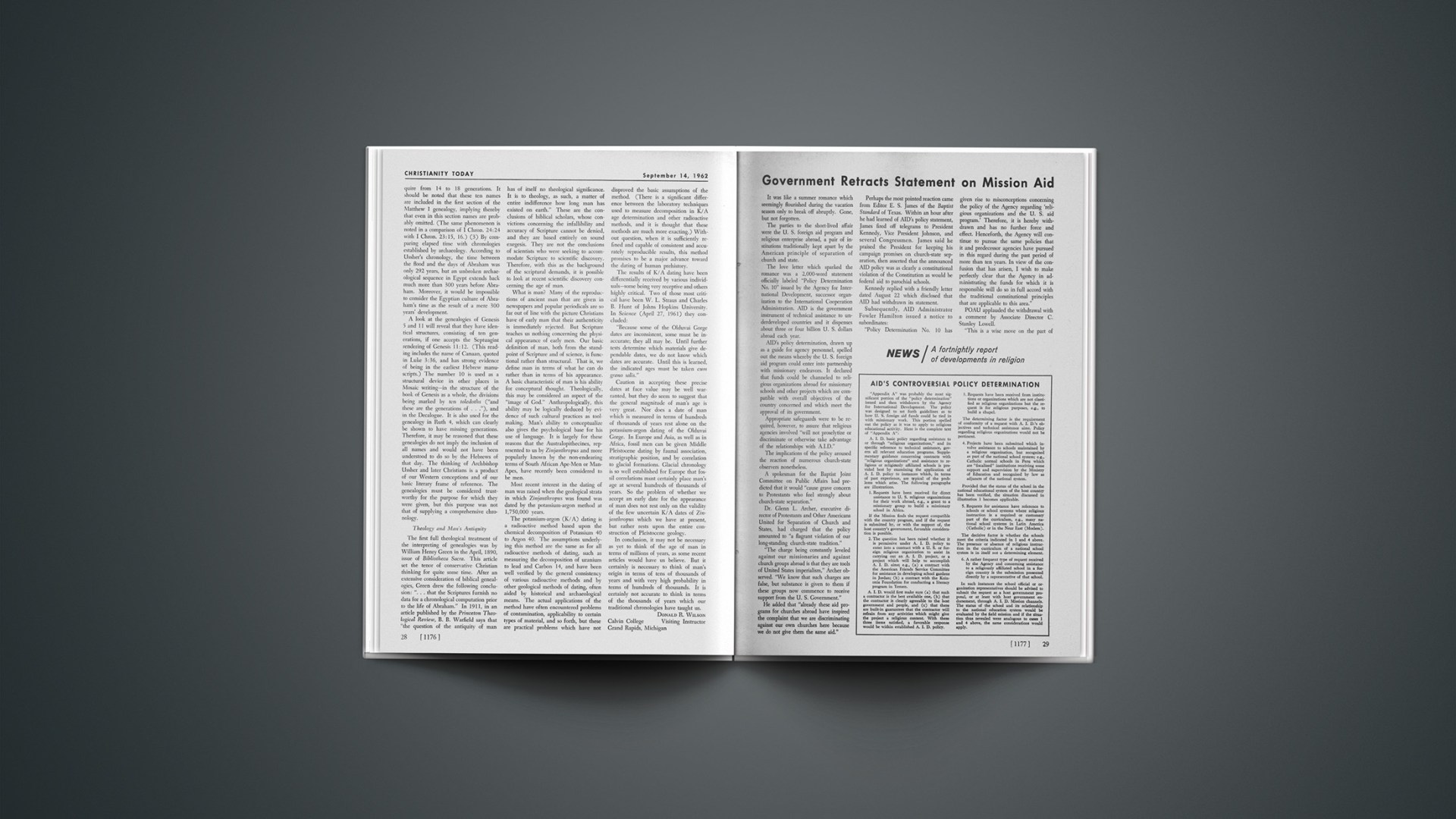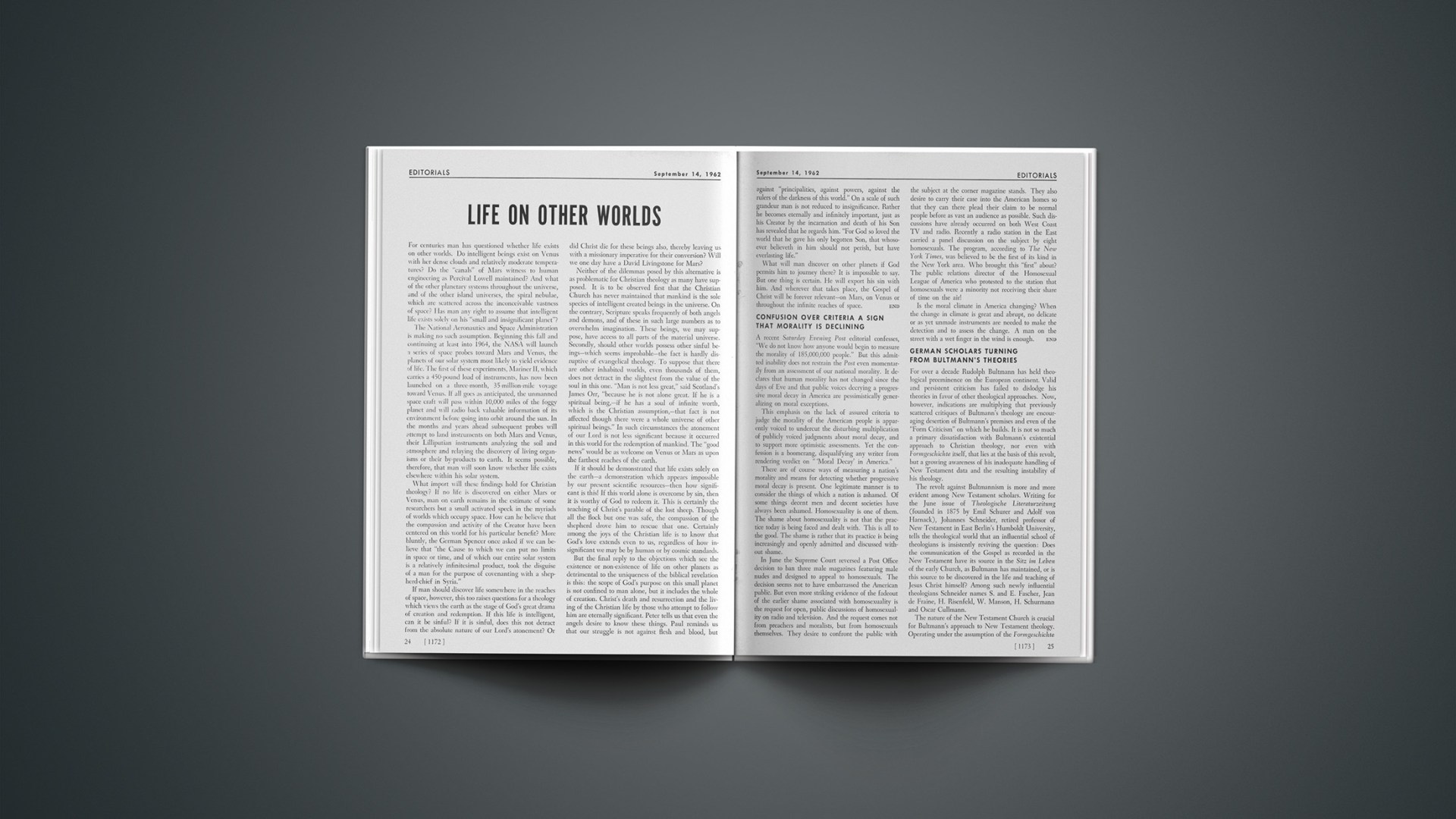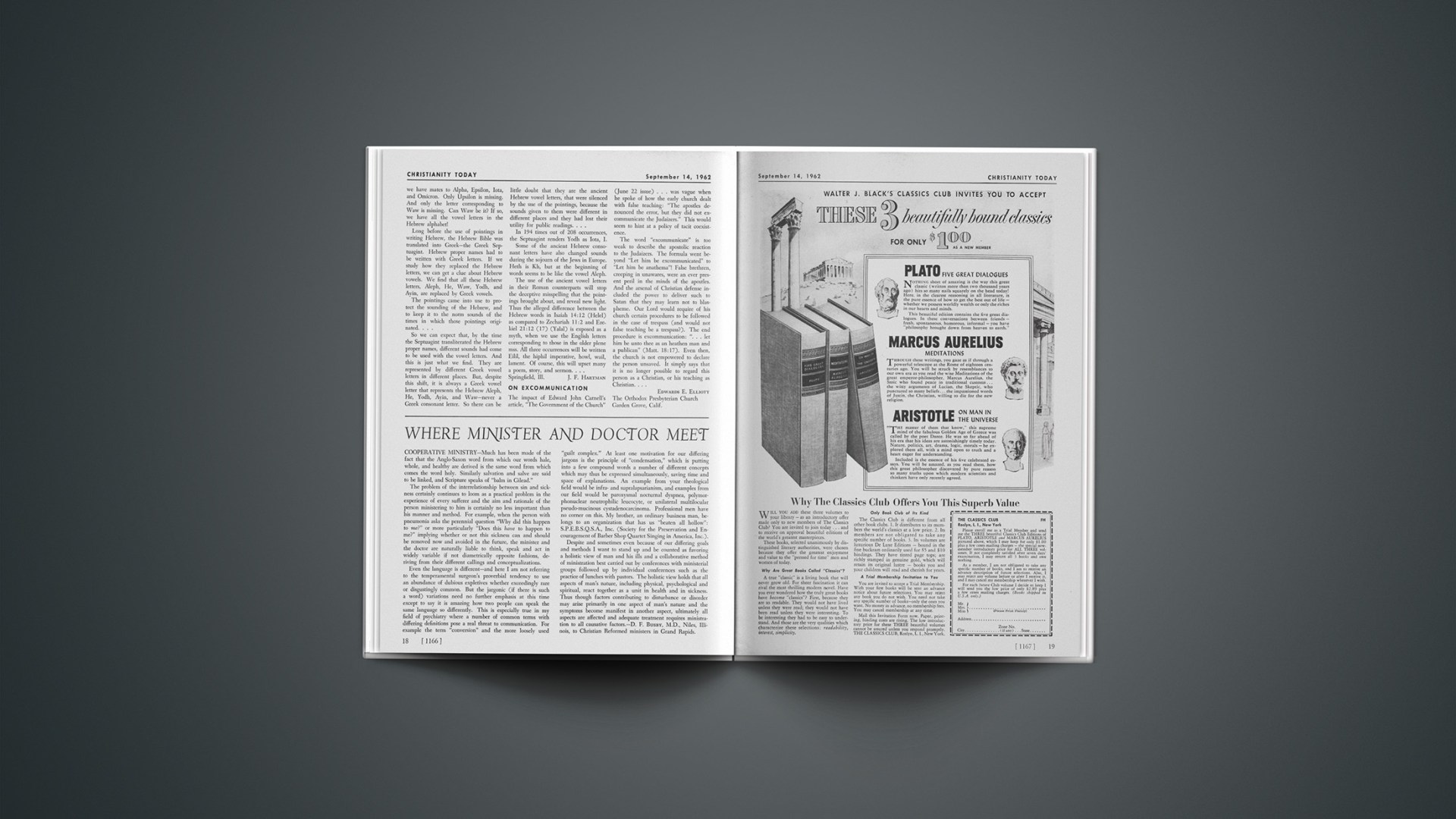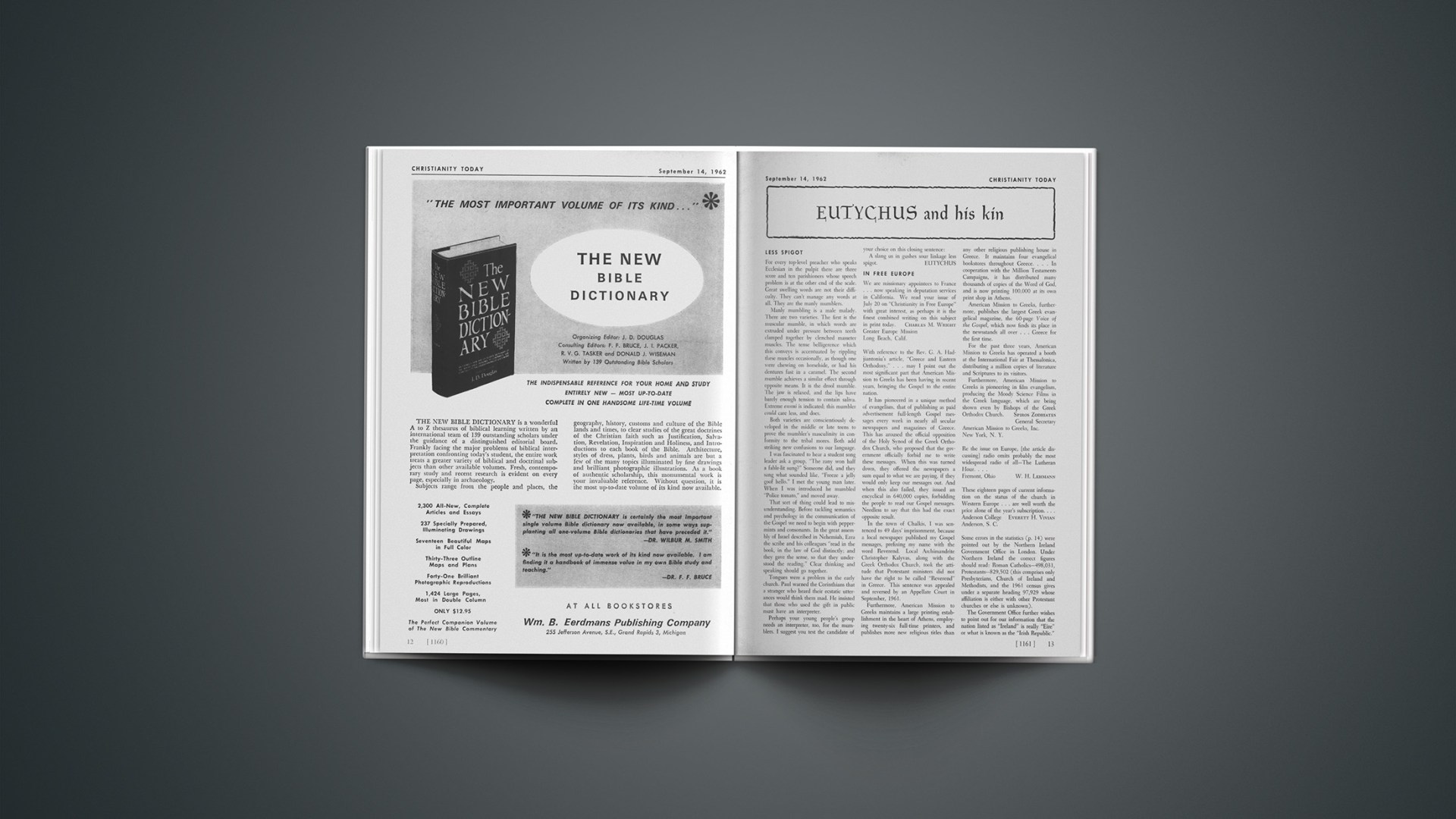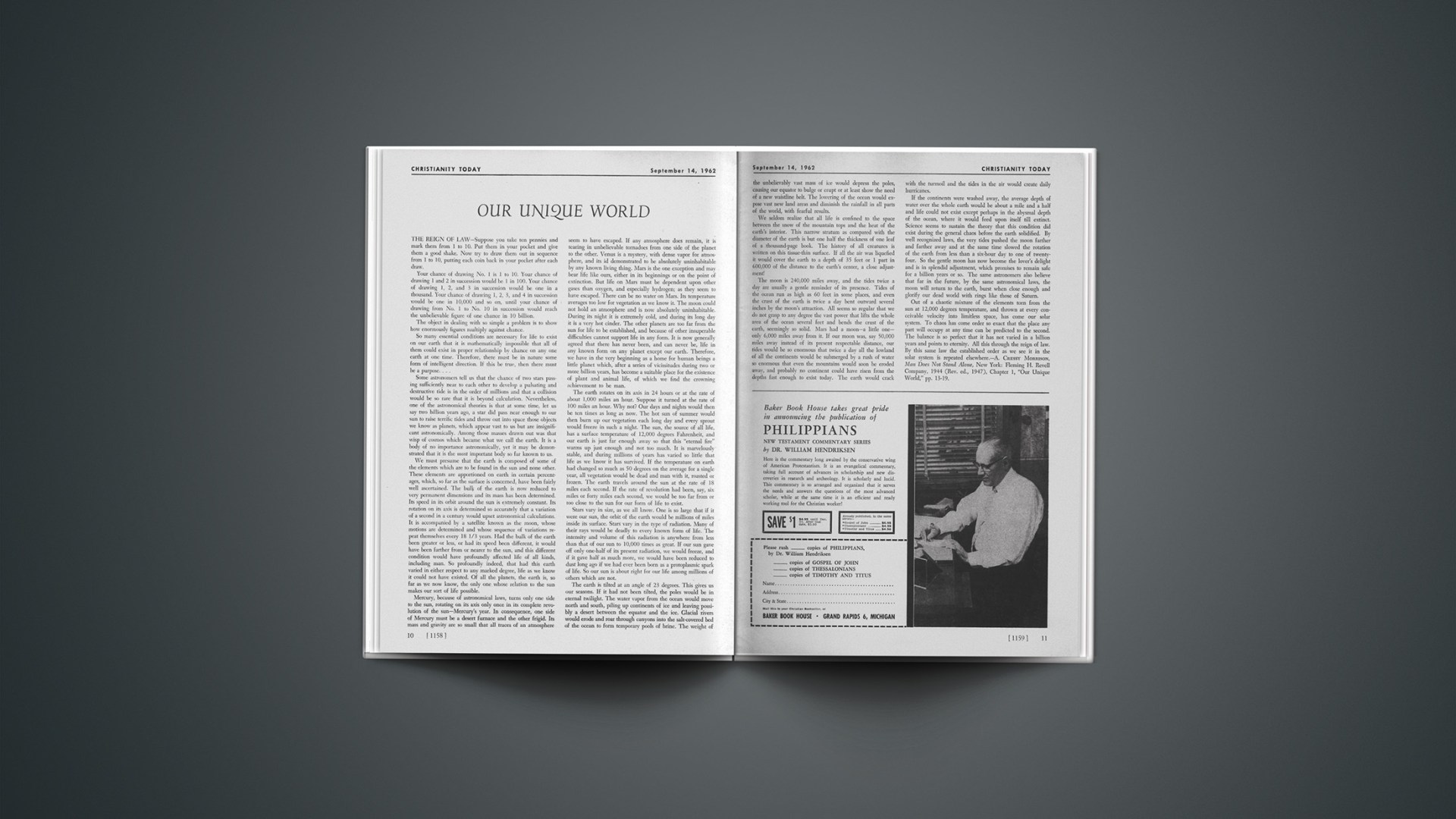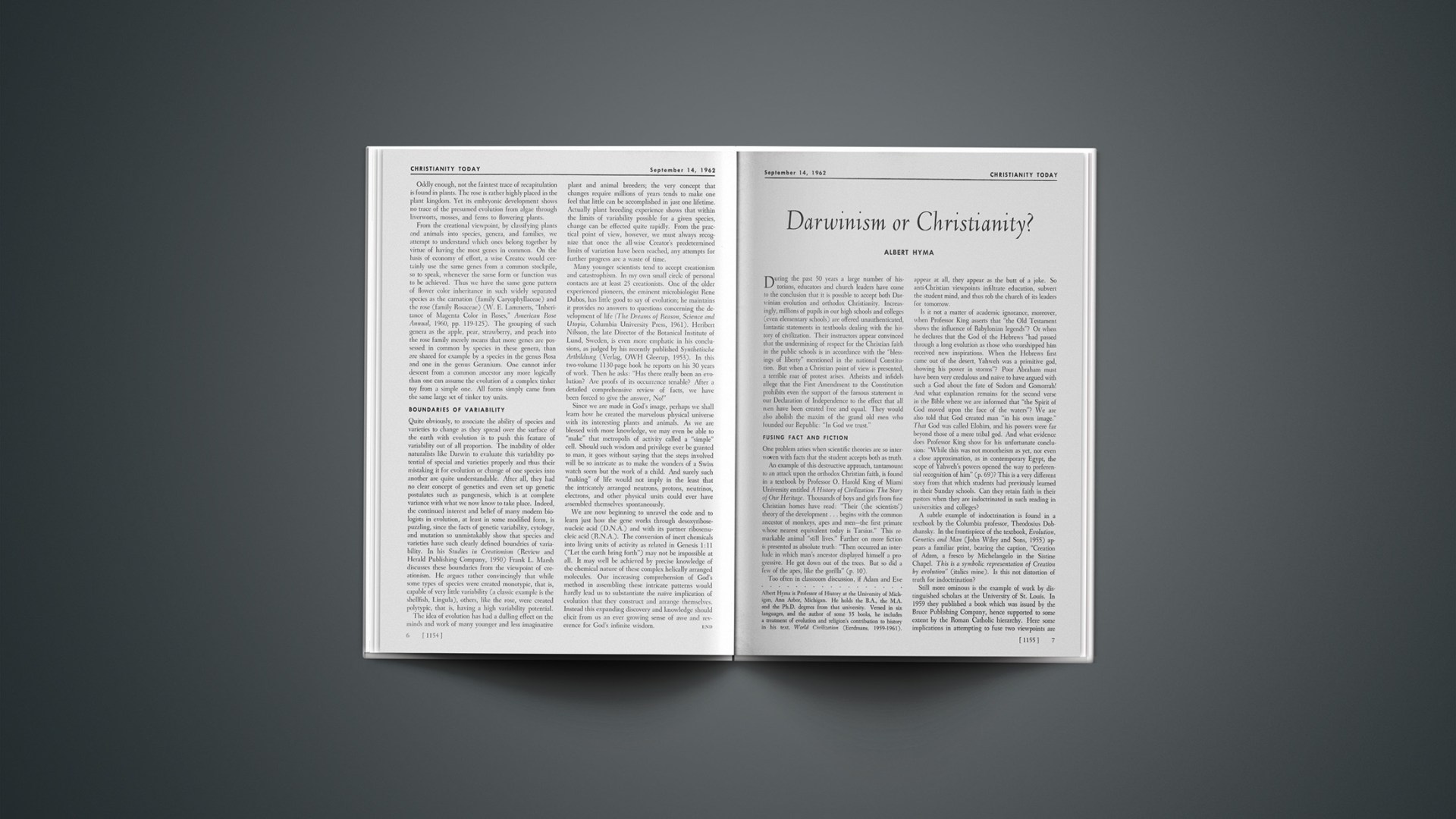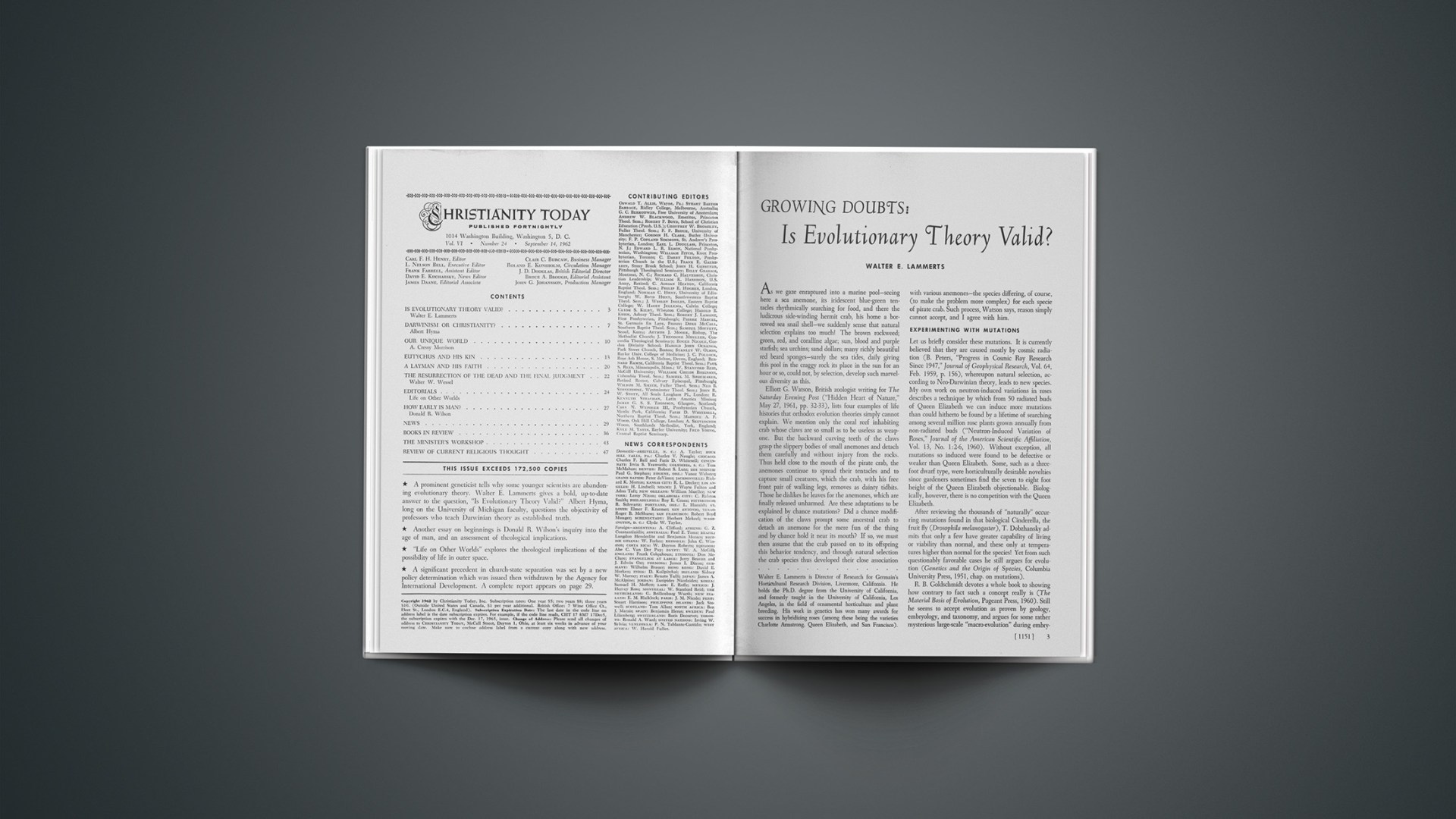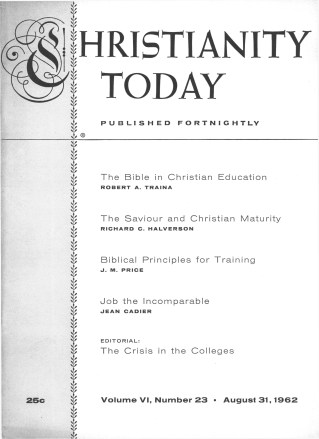The Humorous And The Tragic
The Blood of the Lamb, by Peter De Vries (Little, Brown & Company, 1962, 246 pp., $4), is reviewed by George Harper, Associate Professor of English, Calvin College, Grand Rapids, Michigan.
The trickle of high-level religious novels has become a runnel in the last few years, and it should surprise no one to find even Peter De Vries, the author of The Mackerel Plaza (surely the finest spoof on fading religious modernism in recent literature), adding to the flow with his latest novel, The Blood of the Lamb. De Vries was reared in a strict religious group, the Christian Reformed community of Chicago’s South Side, and the culture he absorbed through the skin, with the habit of strong responses to great human affairs that distinguishes groups which take their religion seriously (all salvation and grace, or none; if none, none with a vengeance), is dyed deeply in him, will not wear away, can be hidden for a time under a suitable cosmetic, but is ineradicable, and hence, perhaps, his choice of theme in this novel.
Choice of theme, but not of plot. The plot is chaotic, episodic, and thin, but the theme, when it finally settles down to work, is the death of a young girl of eight. Worked in and out among the various medical and social and lyric observations on the death of the child (the only daughter of the widowed hero, Don Wanderhope) are De Vries’ pronouncements on faith, doubt, grace, divine love (and hate), cosmic justice, the bad hands dealt one by fate, God, the genes, and so on. To be fair, it should be added that many of these old chestnuts occupy De Vries’ hero in the years when he is growing up in Chicago among the Dutch garbage-collectors of the area, and arise later from his hero’s recollections of his life with his psychotic father and long-suffering mother and other members, lay and clerical, of the Dutch Reformed community. In fact, for the hero, his daughter’s illness and death merely stir up the dormant bitternesses, and it is only fair also to add that these bitternesses are surely more noble in their display at the end of the book than they were at the beginning, with exceptions: there is a disgraceful episode in which the hero, whose daughter has just died, hurls a soggy cake at a Christus in a Roman church, hits the statue full in the face, and has a fantasy in which the statue’s hands slowly rise to wipe the cake out of its eyes. The effect is hardly commensurate with the cause, and De Vries’ hero is left looking like a mildly repentant Robert Ingersoll with crumby hands.
Ideally a review of De Vries’ book should be written in two separate columns, one trailing the other. The book is really two books—a fairly good farce of the kind that De Vries has spent a lifetime bringing to a very high level of development, and a “serious” book with a great theme, well handled for the most part but shading off into uncontrolled melodrama of a particularly sneaky kind, what might be called ironic melodrama. The difficulty is, that the humor and the seriousness and the melodrama are seldom integrated. The fun is often mordant, destructive of what could have been handled more profitably in another way—overlong and overly detailed family prayers before meals, hypocritical wrestlings with unreal religious doubts, and the like, but it seldom illuminates or relieves the serious themes. And the serious parts, though they are often too melodramatic to have their proper effect, show a very deep and credible feeling, of the kind that must have accompanied the actual experience that surely lies behind the book—one can sense the genuine and heartblasting truth of the death of the little girl. Another thing: the sex bits are out of place in this novel, and are not very well done at that. At one point the hero seduces his future wife in her father’s model home, but the whole episode seems to be merely a setup for the exquisite malapropism hissed by the girl’s mother when she discovers the couple in the model bed: “Prude!” Another sex episode is macabre; it involves the hero with a girl dying of tuberculosis, and owes too much, probably, to a fashionable (in the thirties) reading of Rimbaud or perhaps Huysmans. Sex at the edge of the grave is no longer funny. But perhaps De Vries did not mean it to be.
The title of the novel would seem to indicate that its author is about to take a stance relative to religion. What De Vries’ stance is, however, is very difficult to determine. Now this might not be anything to complain of, except that one feels that his apparent neutrality is not the result of deliberate policy but rather of inadvertency. His hero seems to be intended as a bold and heroic agnostic in the grand manner of the 1890s, for at least part of the book, but the day for that is obviously past—it’s hard, hard, to be a bold and heroic agnostic in the grand manner, and has been ever since galluses and The Police Gazette went down. But then again De Vries seems to be reclaiming, through his hero, some of the material of his youth: his hero is made secretly to like old men praying, and to relish old Honest Doubters. The language in these parts of the book that deal with religion strains to express the essence of genuine religious experience, often of rather weak strength though it may be. But the essence is barely discernible, as if a working lifetime of using words for their decayed senses to bring up laughs, of making language gape and drool and snicker, had cut off the author’s access to the language of genuine emotion. De Vries seems to find it difficult to work back to a position from which his verbal shots can really go straight to the mark of meaning. The language of this novel is imprecise, in that it fails to contain the emotions behind it; is often pedantic in an unexpected way (“Dark-complected [complexioned?] Mr. Italia was indeed, with handle-bar mustaches of a size that might have made him topple forward out of his chair were it not for the posture seemingly aimed at correcting the leverage in his favor”), a hangover, perhaps, of New Yorker preciosity; and is at times awkwardly ambiguous (“What enabled me to bear Stein’s apothegms through the highly bibulous luncheon was the knowledge, serenely hoarded, that I would have my sweet home in a day or two” [Home Sweet Home?]).
The Blood of the Lamb fails. Shorn of the horseplay, it could have been a good serious book, a poignant relation of the death of a fair child, enlightening in a proper way; it might have been, shorn of the seriousness, yet another good farce, another risible patricide in a long line of the same kind; it might even have managed to make the best of both worlds, in the fashion of the unhappily neglected Father and Son of Edmund Gosse, poignant too in its recollection of early religious culture and what can be salvaged from it, in its evocation of old pieties now behold with a skeptical eye, and of old certainties now riddled by the grapeshot of modern thought, etc. As it is, the hook is merely amusing and heartbreaking by turns; its deeper tragedy is not only the death of a child, but also the moribundity of a talent and of the heart behind it.
GEORGE HARPER
Gospel In New Guinea
Cannibal Valley, by Russell T. Hitt (Harper & Row, 1962, 256 pp., $3.95), is reviewed by James M. Boice, Editorial Assistant, CHRISTIANITY TODAY.
In September, 1959, seven French explorers began a seven-month, 1,000-mile passage across Dutch New Guinea, popularizing their arduous adventure in a film released this year as The Sky Above—The Mud Below. When it was over, five of the seven had dropped out, three of the native bearers were dead and 30 men were sick with dysentery and malaria. Mr. Hitt’s chronicle of the missionary effort in the Grand Baliem Valley of New Guinea illustrates that once again the adventures of the secular world have been preceded by the brave, sacrificial and visionary missionaries of the Christian Gospel.
These missionaries are not idealized in Hitt’s account. Neither are the outstanding successes of the Christian witness overemphasized. Instead, the reader will discover a vivid, personal portrayal of Christian proclamation, beginning with the vision of Robert A. Jaffray in the 1930s and continuing through 25 years of hardship, discouragement, sacrifice and martyrdom to the eventual establishment of an indigenous Christian Church among men who had once been illiterate cannibals and killers.
As one follows the narration one wishes that there were fewer events to cover and fewer individuals to mention. One also regrets that the personalities of the missionaries, their hopes and discouragements, are not more intimately portrayed. But the Christian reader who will overlook these limitations will find the attempts of native Christians to understand the Christian message and to order their lives in accordance with biblical principles profoundly moving. These incidents are the high points of the narration.
This work is not without shortcomings. But the account, sometimes little more than a chronicle of the missionary enterprise in New Guinea, often sweeps the reader up into its greater vision of the transforming power of the Gospel.
JAMES M. BOICE
Trend Index
Current Issues in New Testament Interpretation, edited by William Klassen and Graydon F. Snyder (Harper, 1962, 302 pp., $5), is reviewed by Merrill C. Tenney, Dean of the Graduate School, Wheaton College, Wheaton, Illinois.
Reading for Perspective
CHRISTIANITY TODAY’S REVIEW EDITORS CALL ATTENTION TO THESE NEW TITLES:
* Man: The Image of God, by G. C. Bcrkouwer (Eerdmans, $6). A leading Christian theologian puts the light of Scripture to man, the image of God who has now become a danger to himself and his neighbor.
* Reformation Studies, edited by Franklin H. Littell (John Knox, $5.50). Essays on both left-wing and classical personalities and movements of the Reformation.
* The Doctrine of Man in Classical Lutheran Theology, edited by Herman A. Preus and Edmund Smith (Augsburg, $3). Disinterment of M. Chemnitz’ and J. Gerhard’s thought on the image of God, free will, and sin. Much of it translated into English for the first time.
The wide influence of Dr. Piper, who is now completing forty years of teaching—twenty-five years at Princeton Seminary—is reflected by the fifteen contemporary scholars who have contributed these essays in his honor. Both American and Continental scholarship are represented by such well known names as Paul Minear, Amos Wilder, Markus Barth, Floyd V. Filson, Rudolph Bultmann, C. K. Barrett, and Johannes Munck. The subject matter covers a wide variety of material: ontology, hermeneutics, the Synoptic problem, the Johannine writings, the Pauline epistles, the nature and development of the early church, and the formation of the canon. Each essay represents some phase of the most recent production in biblical scholarship.
A trend common to all of these essays is the readiness to reexamine the New Testament in the light of its historical and psychological setting and to concede a greater importance to its intrinsic testimony than did the criticism of a generation ago. Irrespective of individual presuppositions, the authors seem to take the biblical text more seriously than did their predecessors. Barth’s essay on “The Old Testament in Hebrews,” Filson’s “The Gospel of Life,” and Barrett’s discussion of “The Theological Vocabulary of the Fourth Gospel and of the Gospel of Truth” contain much useful analysis of textual content.
This work reveals a prevailing unrest in biblical scholarship that has been increasing in the last three decades. Although these writers could not strictly he called conservatives in interpretation, they seem to assume a less cavalier attitude toward the New Testament than prevailed in the older liberalism. They admit that at least some of its history is reliable and that some of its teaching deserves serious consideration. Although not all of their theses will be acceptable to evangelical scholars, and although they do not hold either a high view of inspiration nor a consistent evangelical theology, their thoroughness deserves emulation. Some of their suggestions, like Minear’s argument that the cosmology of the Apocalypse demands a new dimension of thinking, Robinson’s method of analyzing Jesus’ epigrams, and Barrett’s demonstration that the theological vocabularies of John’s Gospel and of the Gnostic “Gospel of Truth” are quite unrelated, can be useful to the student of exegesis and of theology.
In general one may say that these essays are comparatively free from the trivia that occupy many Festschriften, and are a valuable index to the trend of current scholarship. They emphasize interpretation more than speculation. On the other hand, they illustrate by contrast the vast field that is open to evangelical scholars and theologians who will endeavor by patient investigation and by constructive reasoning to demonstrate the contemporary relevance of the Word of God, and to stress its spiritual authority rather than its “problems.”
MERRILL C. TENNEY
Tillich’S Christ
Paul Tillich and the Christian Message, by George H. Tavard (Scribner’s, 1962, 176 pp., $3.95), is reviewed by James Daane, Editorial Associate, CHRISTIANITY TODAY.
Paul Tavard confronts the theology of Paul Tillich with the question, “What think ye of Christ?” After comprehensive, expert analysis Tavard concludes: the man is Christian, the theology is not.
The first half of this judgment does not mean that Tavard adopts Tillich’s contention that the Protestant principle of justification by faith justifies unbelievers and atheists as well as believing sinners. It rests rather on the faith of the man Tillich as it shines through his sermons.
Tillich takes the religious-ethical Protestant principle that the saint in history is yet a sinner and expands it into the philosophical principle that within history there can be no ontological absolutes, no absolute truth, no infallible Bible or Church, no genuine historical Incarnation.
Since the ground of man’s being is said to be in God the Unconditioned, man’s existence (quite in harmony with this expanded Protestant principle) is never equal to his essence. This disparity of existence and essence is Original Sin. Concern about the disparity (when more than merely psychological) is an ultimate concern since it concerns the very ground of man’s existence. Such ultimate concern is faith. This faith is found in all religions and in all serious art, philosophy, and literature.
On the basis of this same principle the Jesus of history is not the Christ. Jesus as the one in whom the ground of man’s being, God’s Godmanhood, is revealed under the conditions of existence, as the one in whom man’s essence and existence are seen reconciled and free from anxiety, is called the Christ, the New Being, the symbol of the ontological victory over all that threatens man’s being. Jesus appears to be the Christ especially on the Cross where without anxiety he sacrifices himself as Jesus.
In Tavard’s judgment such a Christology is not Christian; it fails to do what Chalcedon did: recognize a point in time and history in which the divine and human are united.
Tavard admits writing as late as 1953 that Tillich’s interpretation of the New Being in Jesus as the Christ was essentially correct. He now confesses that the publication of Tillich’s Systematic Theology II (1957) makes this reading of Tillich impossible. Tillich’s Christology is heterodox, incompatible with Chalcedon.
Tavard then goes on to suggest that Tillich’s Christology could be brought in line with Chalcedon by the idea of “God-manhood” which Tavard sees suggested in the biblical ideas of Christ as the “man from heaven,” the “second Adam.” Tavard suggests that these can be interpreted to mean that Jesus Christ is “the second Person, the Man-God,” “the perfect Image of the Father, of whom he is eternally born.” As such Jesus would be “the pre-existent Man” in whom our manhood participates and is grounded. But says Tavard, “A full elaboration would require a separate volume.”
Tavard provides a sympathetic but competent critique of Tillich’s Christology as symbol, as history (perhaps the finest chapter), as dogma, and as ethics.
This book is one of the finest critiques of Tillich’s thought. Although Tavard is a Roman Catholic, his Catholicism does not limit the value of his critique for a Protestant since the norm by which he evaluates Tillich is the Christology of 4th century Chalcedon and that of Luther and Calvin.
JAMES DAANE
Choose You Must!
On Asia’s Rim, by Andrew T. Roy (Friendship, 1962, 166 pp., $2.95; paperback $1.75), is reviewed by Lewis H. Lancaster, for 41 years a missionary of the Presbyterian Church, U.S., in China.
The Christian mission on the rim of East Asia is the theme of World Mission study for 1962–63. On Asia’s Rim is the basic book for adult study of this theme. The author is a missionary of 30 years experience in China and Hong Kong.
Caught in the maelstrom of world politics are 38 million people crowded on the Korean peninsula and the islands of Okinawa, Taiwan, and Hong Kong. In this brief book we are told of the history and culture of these “islands between,” their economic and political conditions and problems, their religions and spiritual needs, and something of the life and work of the Church.
The last chapter is entitled, “You and the Rim of Asia.” “We in the West are deeply involved in East Asia as helping hands and as sources of irritation.” “The issues are drawn, the choices are before us.… We can give our lives in trying to save the peoples of the world in the name of Jesus Christ, or we can try to save our own lives and lose them ingloriously.”
The reading of this book should not only give a new understanding of and an urgent concern for these people, but also stir a more serious determination to meet the responsibilities that we face as followers of Christ.
LEWIS H. LANCASTER
Divine Command?
Death Row Chaplain, by Byron Eshelman with Frank Riley (Prentice-Hall, 1962, 244 pp., $3.95), is reviewed by John A. MacDonald, Minister, First Baptist Church, Mill Valley, California.
Byron Eshelman has been head Protestant Chaplain at San Quentin Prison and Supervising Chaplain for the California State Department of Corrections for more than 11 years. His book, Death Row Chaplain, has been written out of considerable depth of personal experience and for this reason ought to be read by anyone concerned with the issue of capital punishment.
Eshelman states his concern for “a lack of theological perspective and religious depth” in the field of penology and corrections. He also writes with obvious disapproval of capital punishment. But he states that his purpose is more “to analyze what the symptom of capital punishment means in our culture” than to help abolish the death penalty. In the mind of this reviewer the analysis is entirely unsatisfactory. For evangelicals who oppose capital punishment, his argument offers no comfort. He assumes that all administration of the death penalty has always been wrong. He does not in any responsible way consider the theological implications of this assumption. Apparently he classifies the divine commandment of Genesis 9:5, 6 as merely a presumptuous human rationalization of its barbaric custom. Imposition of the death penalty, he claims, has always been a symptom of immaturity in a given culture. Thus Freudian psychology is accorded recognition as authoritative in place of the divinely attested biblical revelation. This is the “theology” of the book.
Unshackled from authoritative revelation, Eshelman is able to scold the self-righteous ones of society who “play God.” He further states his long-held conviction that it is “pharisaism and self-righteousness for Christians to maintain that their religion is superior to all others.”
In following the author through numerous interesting, and in some instances famous, records of criminals, the reviewer was frequently puzzled as to why the parole system was not scrutinized as a possible contributor to the ultimate crimes for which many have been executed.
The familiar problems of injustice, social responsibility, insanity, etc., are handled quite skillfully and no doubt with telling effectiveness upon any sensitive reader. No Christian can be insensitive to the tragic affairs of human life. But the problem must be assessed in terms of the nature of sin and its growing evil effects in human life and society as a whole. Would a “mature” and “responsible” society actually accomplish the “redemptive” effects Eshelman hopes for through his enlightened penology? Or should serious Christian theology humbly assume that the ancient Scriptures reveal God’s infinite wisdom, sufficient to take account of acknowledged problems of human injustice, social responsibility, and insanity, while no sinful society can ever trust itself as truly mature and thus able to reject revelation and law it doesn’t like?
JOHN A. MACDONALD
Something Different
Living Today for God, by Roger Schutz, translated by Stephen McNierney and Louis Evrard (Helicon, 1962, 128 pp., $2.95), is reviewed by Franklin T. Van Halsema, postgraduate student of philosophy, Harvard University, Cambridge, Massachusetts.
The name Taizé has come during the last 20 years to stand for several things, but perhaps for none so unmistakably as for a unique approach to the problem of Christian unity. The Prior of the Reformed monastic community of that name, situated near the more famous Cluny, France, sketches in this book the view of the world and of Christian life in it which has determined that approach.
An excellence of this book is that it exposes the problem of Christian unity as a radically spiritual, rather than theological or church-political, problem. But is it not an “escapist” spirituality which seeks expression in a monastic form of life? Father Schutz does not think so, and gently points out, with more persuasion than can be reproduced here, that a retreat into the “ghetto” of denominational security is “more ‘cloistered’ than any convent.” His book On the Christian life is not a plea for more monastic vocations, and even less for more correct Christian “behavior,” but for stronger commitments to the mission of authentic Christian living. Taizé stands for fulfilling that mission by replacing denominational allegiance with the allegiances of the three old Benedictine vows.
There are some Reformation Christians who are finding in Taizé and in movements such as the liturgical revival more hopeful signs of real ecumenical progress than can be found in the councils and counter-councils pledged to ecumenisms of various kinds. Even the Roman Catholics have taken notice. It is not often that a book by a Protestant author is published first by a Roman Catholic house, introduced by a Cardinal’s letter, and prefaced by one of the Church’s noted scholars.
FRANKLIN T. VAN HALSEMA
Valuable For Some
Ministries of Mercy, by Fern Babcock Grant (Friendship, 1962, 167 pp., $2.95; paperback, $1.95), is reviewed by W. E. Borne, Pastor, Foster Park Baptist Church, Chicago, Illinois.
This book will be of greatest value to those almost entirely ignorant of the scope of the social ministries performed by the churches of America. It is uncritical in its assessment of programs and reads as if the folders sent out for special offerings were used as source material. The author does, however, express concern that social service institutions of the churches sometimes fail to meet the standards for membership in the Child Welfare League of America.
As a survey the book is incomplete. In listing the hospitals sponsored by churches, the author makes no mention of the many hospitals and health services supported by Southern Baptists.
I wish that I could be kinder to this book for there is need for a briskly written book on the many “ministries of mercy” performed or supported by the churches of America. To be of maximum usefulness, however, such a book should critically examine the programs and approaches which may have outlived their usefulness. Since churches cannot do everything, they must seek ways and means to best use the monies and energies that are available. In this search, this book will not greatly help.
W. E. BORNE
Book Briefs
Roman Catholicism, by Loraine Boettner (Presbyterian and Reformed, 1962, 466 pp., $5.95). A thoroughgoing, conservative, often emotional and never exciting contrast of Catholicism with Protestantism. More apt to propagandize than to convince.
What College Students Think, by Rose K. Golden, Morris Rosenberg, Robin M. Williams, Jr., and Edward A. Suchman (Van Nostrand, 1962, 240 pp., $5.95). What college students think about college, fraternities, sex, dating, religious and political matters, and the interesting conclusions they seem to support.
The United Church of Christ, by Douglas Horton (Thomas Nelson, 1962, 320 pp., $4). Author tells the story of the origins, organization, and role of the UCC by reference to its Constitution, and along the way expresses personal comment on many matters.
Financing Medical Care, edited by Helmut Schoeck (Caxton Printers, Caldwell, Idaho, 1962, 314 pp., $5.50). The story of governmental medical care programs in various European countries.
Pascal’s Pensées, translated by Martin Turnell (Harper, 1962, 447 pp., $6). Pascal’s classic apology for religion with material newly ordered and an introduction by the translator.
You Can Witness with Confidence, by Rosalind Rinker (Zondervan, 1962, 105 pp., $1.95). An unusually sane treatment of how to witness to Jesus Christ.
John Colet and the Platonic Tradition, by Leland Miles (Open Court, 1962, 239 pp., $4.50; paper $1.75). Exploration of the Platonic tradition in Colet, Oxford Reformer.
Don’t Park Here, by Paul Erb (Herald Press, Scottsdale, Pa., 1962, 182 pp., $3). A collection of essays on the Christian life, originally published as editorials in the Christian Herald. Brief and topical.
God Is Where You Are, by Alan Walker (Eerdmans, 1962, 128 pp., $2). This addition to the Preaching for Today series by a distinguished Australian preacher is generally fresh and stimulating. The ghost of Rauschenbush lingers on in several places.
The Handbook of Biblical Personalities, by George M. Alexander (Seabury Press, Greenwich, Conn., 1962, 291 pp., $5.75). An alphabetical listing of biblical characters with biography and references. Undecisive on historical and critical problems.
Whom God Hath Joined Together, by Wesley H. Hager (The Upper Room, Nashville, Tenn., 1962, 96 pp., $.75). Devotional guide for the newly married; readings and prayers for the first forty days.
The Disciplined Life, by Richard Shelley Taylor (Beacon Hill, 1962, 102 pp., $1.75). Author pleads the need and value of discipline before a soft, flabby, pampered, self-indulgent generation. Simple, pointed; recommended.
Your Child’s Religion, by the Rev. Randolph Crump Miller (Doubleday, 1962, 164 pp., $2.95). Author raises and answers 88 questions; some answers are excellent, but some of the questions are better than the answers.
A History of Mission House-Lakeland, by Eugene C. Jaberg, Roland G. Kley, Rein-hard Ulrich, Arthur M. Krueger, Theophilus F. H. Hilgeman (Christian Education Press, 1962, 277 pp., $4.95). A centennial volume celebrating the history of Mission House, seminary of the former German Reformed (then Evangelical and Reformed, now United Church of Christ) Church.
The Story of the Good News, by Arthur H. Voerman (Exposition, 1962, 280 pp., $4.50). Author follows the highly dubious procedure of presenting a translation which is paraphrase in which the interpretations of the author appear to fall from the lips of Jesus. Reader will not be sure whether he hears the words of his Lord or those of Voerman.
From Out of the West, edited by P. J. Baird (Lantern Press, 1962, 156 pp., $3.95). Sixteen sermons from 16 Presbyterian ministers of the West breathing something of its expansive mountains and deserts, its storied coast. With pictures of their churches.
A Guide to Daily Prayer, by William Barclay (Harper & Row, 1962, 160 pp., $3). Prayers which reiterate help me, give me, forgive me, keep me (and those I love, or who love me), but lack the dimension of worship and thanksgiving.
The Priesthood of All Believers, by Cyril Eastwood (Augsburg, 1962, 268 pp., $4.50). The place and role of the laymen in the Church as seen in Luther, Calvin, Anglicanism, Puritanism and Methodism.
Paperbacks
The Dynamics of World History, by Christopher Dawson, edited by John J. Mulloy (New American Library, 1962, 480 pp. $.95). Renowned erudite historian probes the relationship of religion and history and urges Christianity as history’s greatest dynamic. Reprint.
Pacemakers of Christian Thought, by James William McClendon (Broadman, 1962, 68 pp., $1). Brief, incisive essays on nine important modern theologians. Theological appetizers calculated to whet the appetite for the reading of Barth, Tillich, Carnell, Bultmann, etc. Done with sympathy and criticism.
Faith That Makes Sense, by J. Edwin Orr (Judson, 1962, 109 pp., $1.45). By use of analogy and popular language author attempts to make Christian faith convincing. First published in 1960.
Homo Viator, by Gabriel Marcel, translated by Emma Craufurd (Harper, 1962, 270 pp., $1.45). A religious existentialist’s reflections on man in pilgrimage. First published in 1951.
A Lawyer Examines the Bible (New Revised Edition), by Irwin H. Linton (W. A. Wilde Company, 1962, 318 pp., $1.85). A lawyer considers the evidence for the truth of Christianity and gives personal testimony to its truthfulness. First printed in 1943.
Reprints
If Thou Shalt Confess, by J. K. Van Baalen (Eerdmans, 1962, 65 pp., $1.50). For those who just have confessed or are about to confess faith in Christ. Very fine, very brief. Revised.
Faith and Its Problems, by Paul G. Schrotenboer (Pro Rege Publishing Co., Rexdale, Ontario, 1962, 114 pp., $1.95). Simple, orthodox answers to big questions in simple, uneven English.



